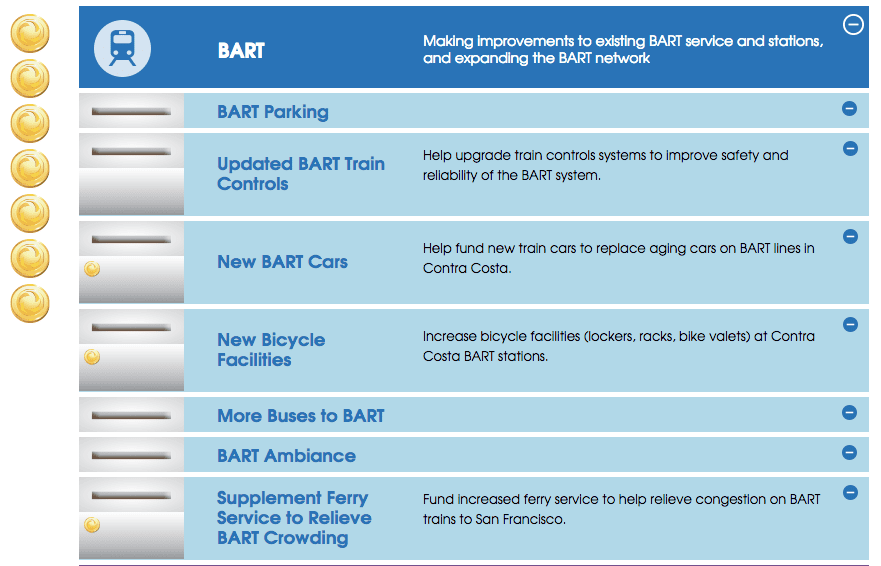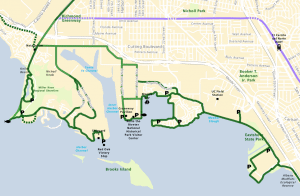
Bay Area traffic is bad. In fact, it’s the second-worst in the nation. So why aren’t more people carpooling? Because carpooling can be difficult. With Scoop, it’s easy.
The Scoop app connects you with commuters traveling in the same direction, building your carpool for you. The app even handles directions and rider-to-driver payments. All you need to do is tell the app where you’re starting from, where you’re headed, and what time you want to leave before the deadline (9pm for the morning commute, 3:30pm for the afternoon) and it does the rest. Plus, your ride home is guaranteed.
Visit 511contracosta.org/scoop for complete details and to download Scoop.
Tag: Contra Costa Transportation Authority
Play CCTA's Online Game: Spend Virtual Money, Give Real Feedback (2015 Promotion)
 The Contra Costa Transportation Authority (CCTA) is gathering public input to help prioritize what projects and programs should be included in their long-term roadmap for future investments – the Transportation Expenditure Plan (TEP). Giving your input is both easy and fun thanks to the CCTA’s online investment game.
The Contra Costa Transportation Authority (CCTA) is gathering public input to help prioritize what projects and programs should be included in their long-term roadmap for future investments – the Transportation Expenditure Plan (TEP). Giving your input is both easy and fun thanks to the CCTA’s online investment game.
The way the game works is simple: You start with ten ‘coins’ which you spend on the projects most important to you. Projects are grouped by category (e.g. BART, Biking, Highways) and to ‘invest’ in a project, you just drag one (or more) coins into the project’s ‘coin box’:

Once you’ve used up all your coins, you can review and submit your investment priorities, as well as share the tool with your friends. Here’s what a completed investment ‘portfolio’ might look like, including the major project categories:

If you’d like to play the game and give your feedback to CCTA, or just want to see which projects have gotten the most support so far, visit keepcontracostamoving.net.

Richmond to San Francisco Ferry Service on Fast Track to Return (2014)

A proposal by the Bay Area Water Emergency Transportation Authority (WETA) could result in ferry service between Richmond and San Francisco as early as 2015.
WETA (the operator of San Francisco Bay Ferry) is responsible for establishing new ferry routes that reduce traffic congestion and can serve as critical transportation in the event of an emergency. Although Martinez, Antioch and Hercules were among the potential locations considered for terminals in Contra Costa, “The most financially feasible is Richmond,” said Kevin Connolly, Manager of Planning and Development with WETA.
According to Richmond City Councilmember Tom Butt, “There are a number of factors influencing the decision to implement the Richmond to San Francisco ferry service before other potential routes.” For one, capital costs to re-fit the existing Richmond Ferry Terminal at Ford Point are far lower than for the other proposed expansion projects. In addition, projected 2015 ridership for the Richmond Terminal is strong (at 950 daily boardings), with fare revenues expected to cover up to 45% of operating costs. Although the balance would need to be covered by Measure J sales tax funds, $45 million has already been earmarked for ferry service in Richmond and Hercules.

The site of the proposed ferry terminal is about 1.5 miles south of downtown Richmond, making it extremely accessible by various modes of transportation. Ford Point is on the Bay Trail, making biking to the proposed ferry terminal simple enough. AC Transit Route 74 (which also connects to Richmond BART) makes the trip Monday-Sunday from Downtown Richmond to Ford Point in just 17 minutes. And for those getting to the ferry terminal by car, a large parking area already exists at the site.
At present, the project is undergoing environmental impact reviews, which should be completed by fall of this year. Once these are completed, final design, permitting and construction of terminal improvements and vessels can begin. This means Richmond ferries could be running as early as 2015. As far as the actual timeline, “The real thing that drives it is how long it takes to build boats,” according to Connolly.
The estimated travel time of the new ferry between Richmond and San Francisco is 23 minutes, compared with 38 minutes by BART and 28 minutes by car (without traffic). The final fare structure has not yet been announced, but some lucky passengers were able to get a sneak preview on a test run of the new route in July of this year.
The Contra Costa Transportation Authority (CCTA) is currently soliciting feedback on what type of transportation investments people would like to see at KeepContraCostaMoving.net.
To view full details of the Richmond Ferry Terminal Project, visit the information page on the WETA website.
